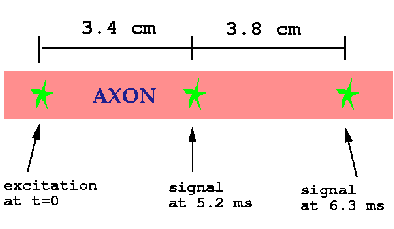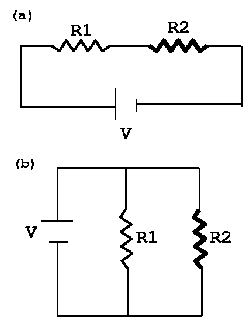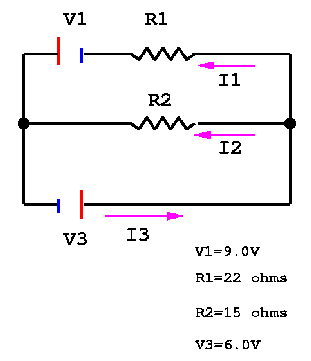
Q15)Some lamps might have batteries connected in either of the two arrangements shown in Fig.18-30. What would be the advantages of each scheme?
SOLUTION:

P31)An ordinary flashlight uses 2 D-cell batteries (1.5 V each) and draws 350 mA when turned on. (a) Calculate the resistance of the bulb and the power dissipated. (b) By what factor would the power increase if 4 D-cells in series were used with the same bulb? (Neglect the heating effects of the filament.) Why shouldn't you try this?
SOLUTION:
(a) V = I x R
R = 2 x 1.5-V / 0.35 A = 8.6 ohms
P = V2 / R = 92/ R =
(9-V2) / (8.6 ohms) = 1.05 W
(b) Power would increase by a factor of 4. Using
4-cells would thus, not be a good idea since the bulb
will
probably burn out.
P46)A heater coil connected to a 240-V ac line has a resistance of 34 ohms. What is the average power used? What are the maximum and minimum values of the instantaneous power?
SOLUTION:P52)A nerve is stimulated with an electric pulse. The action potential is detected at a point 3.40 cm down the axon 0.0052 s later. When the action potential is detected 7.20 cm from the point of stimulation, the time required is 0.0063 s. What is the speed of the electric pulse along the axon? (Why are two measurements needed instead of only one?)
SOLUTION:

Q4)Two lightbulbs of resistance R1 and R2 (> R1) are connected in series. Which is brighter? What if they are connected in parallel?
SOLUTION:

P22)What is the internal resistance of a 12.0-V car battery whose terminal voltage drops to 8.8 V when the starter draws 60 A? What is the resistance of the starter?
SOLUTION:
R = starter resistance and r = battery internal
resistance
voltage drop across resitor r is 3.2 V =(I x r) so r
= (3.2 / 60) ohms = 0.053 ohms
(r + R) = 12 V / 60 A so R = 0.2 ohms - 0.053 ohms =
0.147 ohms.
P24)Calculate the current in the circuit of Fig. 19-36 and show that the sum of all the voltage changes around the circuit is zero.
SOLUTION:
9.0 V = I (2.0 ohms + 8 ohms + 2 ohms)
I = (9 / 22) A = 0.41 A
P28)Determine the magnitudes and directions of the currents through R1 and R2 in Fig 19-37.
SOLUTION:
For the loop containing V1,
R1, V3,
sum of the voltage sources is 9.0 V + 6.0
V = 15 V. The sum of the voltage drop is I1 R1
so,
15 V = I1 R1 and I1
= 0.68 A
For the bottom loop,
6.0 V = I2R2,
I2 = 0.4 A